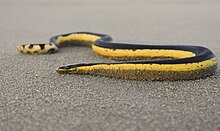




The extant (living) reptiles of New Zealand consist of numerous species of terrestrial lizards and the lizard-like tuatara, and several species of sea turtles and sea snakes.[1] All but one species are native to New Zealand, and all but one of the terrestrial species are endemic to New Zealand, that is, they are not found in any other country. Many species of foreign reptiles enter New Zealand through accidental importation or smuggling,[2] but only the Australian native Lampropholis delicata (rainbow skink or plague skink) has become established in the wild,[1][2] and it is considered an invasive pest.[3]
Long-extinct taxa include numerous dinosaurs and other Mesozoic reptiles that are known from fossils found in New Zealand.
Taxa[edit]
Modern taxa
- Lizards
- Geckos – at least four dozen species, and probably more yet to be scientifically described
- Skinks – over 70 endemic species in the Oligosoma genus, plus the introduced Lampropholis delicata (rainbow skink or plague skink)
- Tuatara – one unique species of this "living fossil" that looks like a lizard, but is not one. Snakes are closer relatives to lizards than the tuatara is.
- Sea turtles[4]
- Leatherback sea turtle (Dermochelys coriacea) – widespread around New Zealand
- Green sea turtle (Chelonia mydas) – found around the northern North Island
- Loggerhead sea turtle (Caretta caretta) – occasional visitor to the main islands of New Zealand
- Hawksbill sea turtle (Eretmochelys imbricata) – rare visitor to the main islands
- Olive ridley sea turtle (Lepidochelys olivacea) – rare straggler to New Zealand
- Sea snakes[5]
- Yellow-bellied sea snake (Hydrophis platurus) – occasional visitor to the northern half of New Zealand
- Yellow-lipped sea krait or banded sea krait (Laticauda colubrina) – rare straggler to New Zealand
- New Caledonian sea krait or Saint Giron's sea krait (Laticauda saintgironsi) – rare straggler to New Zealand
- Blue-lipped sea krait or brown-lipped sea krait (Laticauda laticaudata) – extremely rare straggler to New Zealand
Extinct ancient taxa
Long-extinct taxa include numerous dinosaurs and other Mesozoic reptiles that are known from fossils found in New Zealand. The New Zealand mosasaur, named Moanasaurus, was one of the largest mosasaurs in the world. The New Zealand plesiosaur is named Mauisaurus.
See also[edit]
References[edit]
- ^ a b Conservation Status of New Zealand Reptiles, 2021 (PDF). New Zealand Threat Classification Series 35. Department of Conservation, New Zealand. Retrieved 20 August 2023.
- ^ a b Gill, B. J.; Bejakovich, D.; Whitaker, A. H. (2001). "Records of foreign reptiles and amphibians accidentally imported to New Zealand". New Zealand Journal of Zoology. 28 (3): 351–352. doi:10.1080/03014223.2001.9518274. S2CID 85031652.
- ^ "Plague skinks". Department of Conservation, New Zealand. Retrieved 20 August 2023.
- ^ "Sea turtles". Department of Conservation, New Zealand. Retrieved 20 August 2023.
- ^ "Sea snakes and kraits". Department of Conservation, New Zealand. Retrieved 20 August 2023.
External links[edit]
- New Zealand Herpetological Society
- New Zealand reptiles and frogs, Department of Conservation
Well, that’s interesting to know that Psilotum nudum are known as whisk ferns. Psilotum nudum is the commoner species of the two. While the P. flaccidum is a rare species and is found in the tropical islands. Both the species are usually epiphytic in habit and grow upon tree ferns. These species may also be terrestrial and grow in humus or in the crevices of the rocks.
View the detailed Guide of Psilotum nudum: Detailed Study Of Psilotum Nudum (Whisk Fern), Classification, Anatomy, Reproduction